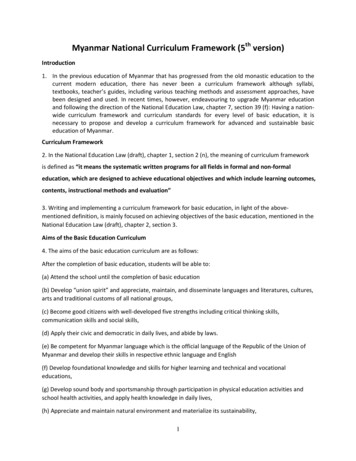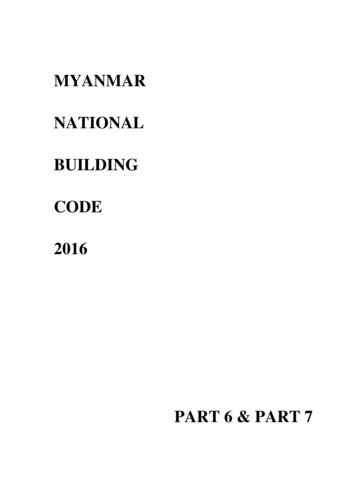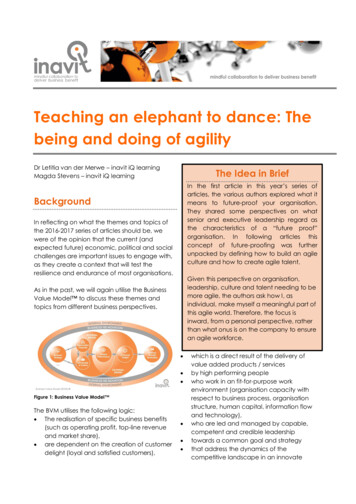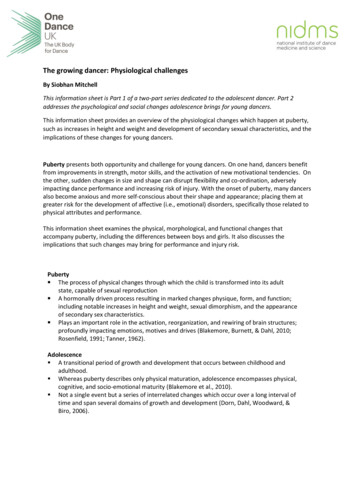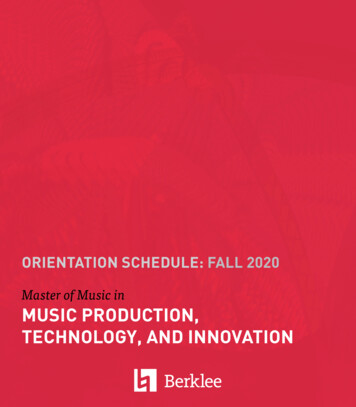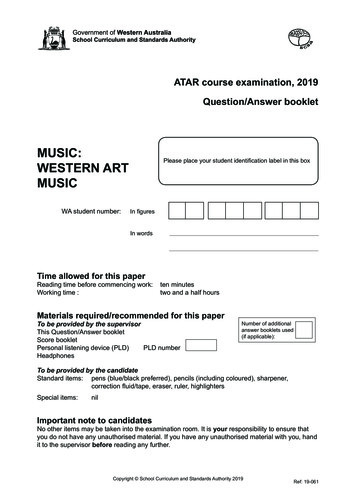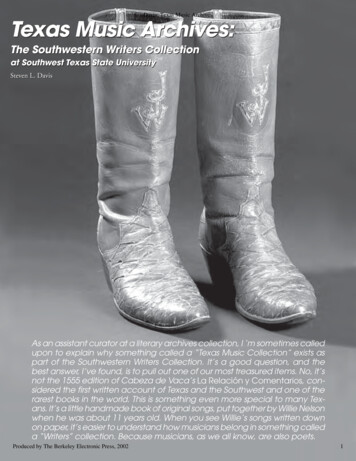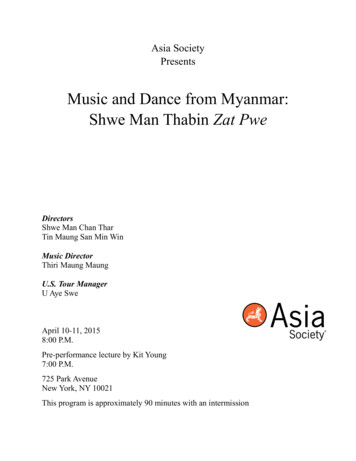
Transcription
Asia SocietyPresentsMusic and Dance from Myanmar:Shwe Man Thabin Zat PweDirectorsShwe Man Chan TharTin Maung San Min WinMusic DirectorThiri Maung MaungU.S. Tour ManagerU Aye SweApril 10-11, 20158:00 P.M.Pre-performance lecture by Kit Young7:00 P.M.725 Park AvenueNew York, NY 10021This program is approximately 90 minutes with an intermission
Music and Dance from Myanmar:Shwe Man Thabin Zat Pwe Program“Ta Khaing Lon Shwe” (The Spray of Golden Flowers)“Ti Lon” - Instrumental PreludeU Han Ba (1888-1966), ComposerThiri Maung Maung Shwe Ta Sait Hsaing Waing Ensemble1. Phaya Gadaw Kan (Invocation Prayer to the Buddha)Shwe Man Thabin CompanyA. Si Mi Kwet A Ka (Candlelight Offering Dance)San Shwe Sin, MinthameeB. Pwe Taw Hmyauk (Raising the Offering Bowl to the Nat Spirits)Shwe Joe Jar, MinthameeC. Hpakant Min Pu Zaw (Offering to the Nat King of Hpakant)San Min Aung, MinthaSan Shwe Sin, Minthamee2. Hni Ko Hkwe Myaing Hta (The Royal Duet in a Sylvan Setting)Shwe Man Chan Thar dances both Mintha and Minthamee roles3. Sagaing Byaw: So - Ti -A Ka (The Byaw Tune from Sagaing: Song, Music, Dance)Composer: A-1 Saya HnyaShwe Man Win Maung, Mintha VocalistChit Swan Thar, Awra Aung, Mintha Duet; Shwe Joe Jar, Minthamee4. Kyei Let Pyaing Pwe: (Folk Dance Medley and Competition)Shwe Man Chan Thar, Eastern Village MinthaTin Maung San Min Win, Western Village MinthaSan Shwe Sin, Central Village Maiden5. Htamein Na Hke A Ka (The Flicking of the Htamein Skirt’s White Train Dance)Shwe Joe Jar, Minthamee6. Yok Thay A Ka (The Dance of the Marionettes)Saw Yu Nwe, PuppeteerSan Min Aung, Marionette7. San Taw Kyein Ti Lon Hnin Mintha Yein (Proclamation Music and Mintha Group Dance)Composer: Sein Ba Maung KaleiChit Swan Thar, Awra Aung, San Min Aung, Ye Yint Htet Aung, Mintha Ensemble
8. Man Nat Hnin Tha Mi Thon Paw (Mara Sends His Three Daughters to Tempt the MeditatingBuddha) Excerpt from the Music-Drama (Myanmar ‘Opera’) by Shwe Man Tin MaungTin Maung San Min Win, Mintha; Shwe Joe Jar, San Shwe Sin, Saw Yu Nwe,Minthamee EnsembleIntermission9. Khit Thon Khit Hni Pa Thwa (The Royal Duet and Pledges of Loyalty: Dance From Three Eras)A. Myay Waing Khit (Ground Circle Zat Thabin Era 1870’s)Shwe Man Win Maung, Mintha; Shwe Joe Jar, MinthameeB. A Linga Khit (A Linga Kyaw Swa Shwe Man Tin Maung’s Era 1930’s-1969)Shwe Man Chan Thar, Mintha, San Shwe Sin, MinthameeC. Ya Ne Khit (Contemporary Times)Tin Maung San Min Win, Mintha; Minthamee EnsembleD. Lu Shwin Taw Pa Ri Hkan (Comedians’ Introduction for Hna Pa Thwa)Chit Swan Thar, Awra Aung, Mintha ClownsE. Mintha A Swan Pya (Virtuosic Display of the Mintha)San Min Aung, Mintha and Minthamee EnsembleF. Lu Shwin Taw Hatha (Joking of the Comedians)Chit Swan Thar, Awra Aung, Mintha ClownsG. Mintha and Minthamee A Ka (Dance of the Mintha and Minthamee)San Min Aung, Mintha and Minthamee EnsembleH. Lu Shwin Taw Hatha (Joking of the Comedians)Chit Swan Thar, Awra Aung, Mintha ClownsI. “Wat Lat” Son Twe Mintha Paun Su A Ka (Trio Couples Dance in Wa Lat Tempo)All Mintha and Minthamee Couples10. “Aung Ba Sei” (May Success Be Yours)Sa Hkan Thein (Zat Pwe Finale)Shwe Man Thabin CompanyComposer: A1 Saya Hnya11. Mingala Pwe Thein Byaw (Instrumental Postlude and Farewell)Thiri Maung Maung Shwe Ta Sait Hsaing WaingThiri Maung Maung (Pat Waing Saya - drum circle leader)Ne Lin ( Hne Saya - (oboe leader) )Sein Win Ko (Kyay Waing - knobbed gong circle)Way Yan Maung Maung (maung -gong set)Kyi Than (Pat Ma Gyi, Kyauk Lon Bat- Large Drums)San Sint Maung Maung (Oht Son - Rhythm SectionNge Naung (Si Wa Cymbal and Clapper Time Markers)
Shwe Man Thabin Program NotesBy Kit Young with Ne Myo AungGitameit Music CenterAbout Zat Pwe:Zat in Burmese refers to the jatakas tales, the 550 stories from India of the Buddha’s earlier incarnationsthat serve to instruct moral behavior. 15th century accounts suggest that marionettes, not humanperformers, in both royal court and village life enlivened the jataka stories as public drama. Gradually,“zat” began to mean actors and actresses taking on the roles of marionette characters. New dramaticforms were added to the staging of the jataka tales.Zat in Burmese language also refers to a troupe of performers (a hpwet) and an all-night, outdoorperformance (pwe). Usually, these performances take place on the grounds adjoining a temple duringparticular Buddhist festivals and holidays. In today’s Myanmar, very few zat thabin troupes cansurvive the enormous cost of maintaining a large troupe and touring schedule.The culture, history and artistic languages of zat are known as zat thabin: the world of zat theaterreflecting Myanmar, past and present.About Shwe Man Thabin Zat Pwe:Shwe Man Thabin (Golden Mandalay Theater) zat troupe was founded in 1933 by Alinga Kyaw Swa(Performer Laureate) Shwe Man Tin Maung, a renowned performer known for his innovation within thetraditions of the classical zat pwe. The troupe continues today through the perseverance and talents of hissons and daughters, and now, his grandchildren. Each is a nationally and internationally recognizedperforming artist in their own sphere, well versed in the skills of a zat performer: dancing, acting, singing,and improvised speaking, as well as writing, directing and producing plays. Shwe Man Thabin is the lastof the family dynasties to remain in the zat performance community, and celebrated their 80th anniversaryin 2013. Today's Shwe Man Thabin has two touring zat troupes in Myanmar: Shwe Man Chan Thar, sonof Alinga Kyaw Swa Shwe Man Tin Maung directs one troupe and Tin Maung San Min Win, thegrandson of Shwe Man Tin Maung and directs the other troupe.Program Notes:Ta Khaing Lon Shwe (The Spray of Golden Flowers)U Han Ba (1888-1966), ComposerA Sa Ti Lon: (Hsaing Waing Music Opening Tonight’s zat pwe)An all-night, outdoor zat pwe opens with an instrumental prelude, known as a ti lon alerting the audiencethat the zat pwe is starting. Tonight, Shwe Man Thabin opens their program with “Ta Khaing Lon Shwe”(The Spray of Golden Flowers), by celebrated composer U Han Ba. The song’s lyrics are about goldenflower sprays such as the “badauk,” sparkling in trees and showering delight and good luck. This ispeculiarly true of their blooming season in April, which marks the New Year. It is celebrated in theThingyan water festival (in 2015 this festival begins on April 14th).
1. Phaya Gadaw Hkan (Invocation Prayer to the Buddha)A. Si Mi Kwet A Ka (Candlelight Cup Dance)In Zat Thabin (theater) and older Yok Thay Thabin (Marionette Theater) traditions, performersinvoke a prayer to the Buddha at the start of the pwe. They make a candlelight offering to theBuddha and perform dances propitiating a pantheon of deities in Myanmar known as “Nats,”which ensures that nothing unto ward will happen in the pwe. The hsaing waing accompanies theperformers during their singing of “Htu Ma Chana.” Htu Ma Chana (The IncomparableBuddha) was composed by Myawaddy U Sa, a gifted minister of the Konbaung Dynasty (early1800’s). The song uses a classical-style structure of “Thakyin Kan” from a great canon ofcenturies-old song genres collectively known as the “Mahagita.” The lyrics of these old songs areprimarily secular. In some song genres however, lyrics praising the Buddha are used on occasionsfor lay worship and shared in the theater.Si Mi Kwet A Ka (Candlelight Cup Dance) is a Buddhist offertory which is performed by aminthamee (“princess” in the Myanmar language, also a female dancer/actress) during theplaying of the song Htu Ma Chana.B . Pwe Taw Hmyauk (Raising up the Golden Bowl of Offerings to the Nat Spirit)The original, royal court version of the A Pyo Taw (Royal Maiden) dance gradually evolved intoa series of refined movements associated with the Burmese A Nyeint, a form of minthamee dancewith singing and dialogue popular after the fall of the Konbaung dynasty in 1885. As zat thabintroupes proliferated in the 20th century, some of these earlier gestures merged with those familiarto both rural and urban audiences from trance-dancers Nat Gadaw in a Nat pwe.C. Hpakant Min Pu Zaw (Propitiating)In Myanmar’s zat thabin, a performance must begin with a prayer for the Buddha’s blessing.According to Buddhist beliefs, this has been a custom for audiences and performers. Zat thabinperformers must pay respect to the Buddha first with an offering of candles and flowers and thento the Nat spirits. From this propitiation, the performance will proceed smoothly, with noaccidents, and dancers will come to the stage with right focus. Nat spirits at all cardinal points ofthe universe must receive praise with offerings of a coconut, bananas, auspicious eugenia flowers,candles, and perfume. This presentation and the accompanying graceful dance is performed by aminthamee in the “Pwe Taw Hmyauk A Pyo Taw.” To gain the blessing of the powerful andmacho Ko Gyi Kyaw Nat, a mintha (“Prince” in the Myanmar language, also dancer/actor) andminthamee enter to the cascading cymbal and drum beats of “Hpakant Min Pu Zaw” (Offeringto the King of Hpakant) following the A Pyo Taw dance. This is a more vigorous dance to honorKo Gyi Kyaw, one of the patron Nats for performing artists. Dancers offer their symbolic tranceecstasy to Ko Gyi Kyaw miming gestures from the Nat pwe of drinking, eating, and smoking, toenter into communion with the Nat so as to calm him and have him bless the night’s performance.
2. Hna Ko Hkwe Myaing Hta (The Royal Duet in a Sylvan Setting)This duet dance between mintha and minthamee, informally referred to as “Myaing Hta” in the world ofzat thabin, is a dance with hsaing waing accompaniment derived from a longer, extended form ofdialogue, singing, and clown commentary called “Hna Pa Thwa” occurring at the end of the night at a zatpwe. The mintha and minthamee must demonstrate their gracefulness on stage, show deep emotion in thedance and show intricacy in their duet steps and let cho—the language and delicacy of hand gestures.Two of the most famous minthas of the early twentieth century, U Aung Bala and U Sein Gadon, dancedthe Myaing Hta in the days when a mintha and minthamee were not allowed any physical contact onstage. The graceful performer U Aung Bala became famous for his dancing of minthamee roles andsinging Ngo Kyin (Weeping Songs) in a high-pitched voice in duet with mintha U Sein Gadon dancing therole of the royal prince. Chan Thar as a soloist dances both mintha and minthamee roles in hischoreography for Shwe Man Thabin. (i)The Myaing Hta is said by certain commentators in Myanmar to have originated from duet forest scenedances in the Thai Ramakien and Inao dramas which together with stage music were absorbed into aBurmese idiom by the royal courts in the Inwa and early Konbaung dynasty (ca. late 1700’s-early1800’s). The songs accompanying Myaing Hta are called “Yodaya” Burmese language for the Thaicapital Ayudhya) and played in a distinctly calming style with a mode and timing specific for the genre.The Burmese lyrics for these songs frequently describe the beauty of the forest and longing for a lost ormissing love.Shwe Man Thabin’s founder Alinga Kyaw Swa Shwe Man Tin Maung (1918-1969) originally danced the“Hni Ko Kwe Myaing Hta” during one of his most popular operas, Hle Tha Ngaya. In this story, amerchant on his route across a great desert with 500 wagon-carts of goods and travelers arrangesentertainment at a rest stop for his passengers. In this scene, Alinga Kyaw Swa Shwe Man Tin Maunginserted the “Hna Ko Myaing Hta” dance with an innovation that audiences loved. He at first dances themintha role and then, behind a lowered curtain on stage, he changes costume, while music plays, andemerges seconds later, dressed as a minthamee and dances with female gestures. The scene derives from afabled scene of a prince and princess who finish their Buddhist studies at Taxila University (in thePunjab). On their journey home, in the forest, the princess tires and while they rest, the prince declares hisundying devotion to her in song and dance. Supporting dancers are the stage audience watching thecouple from the Opera “Hle Tha Ngaya.”3. Sagaing Byaw (Byaw Tune from Sagaing, composed by A-1 Saya Hnya)The Sagaing Byaw tune and accompanying dance are examples of Alinga Kyaw Swa, Shwe Man U TinMaung’s many and fruitful collaborations with composer A-1 Saya Hnya. In Myanmar’s merit-makingand alms-giving ceremonies in the central plains city of Sagaing, the exciting music of the gongs pairedwith clashing cymbals encourages townspeople to make merit by donating to temple projects.
4. Kyei Let Pyaing Pwe (Folk Dance Medley and Competition)Alinga Kyaw Swa Shwe Man Tin Maung not only choreographed traditional dances but also performeddances with different village customs, one being a competition dance. In this scene, a maiden from acentral village watches the talents of two young male dancers vying for top place, egged on by jokes andthe hsaing waing’s breathless passagework.5. Htamein Na Hke A Ka (The Flicking of the Htamein Skirt’s White Train Dance)A minthamee in the A Nyeint dancing tradition wears an exaggerated stage version of a Burmese woman’saingyi (a blouse with fluted wings) matched with a htamein (a traditional skirt with a long white train).The minthamee as a dancer must know how to use the hem of the costume’s long train for artisticeffect. This ability was crucial for the earlier days of minthamee performance. The minthamee mustcarefully use her ankles and feet to flick the hem of the train sideways, upwards and to the back. Thisprecision is closely watched and felt by musicians who must accent the “swish” of the long cloth train.6. Yok Thay A Ka (The Dance of the Marionettes)The Marionette tradition, with its unique properties and meaning in Myanmar culture, extends back toearly kingdoms of Pagan period. In 702 CE, during the T’ang Dynasty in China, and Pyu Kingdom inMyanmar, a troupe of Pyu (P’iao in Mandarin) musicians and dancers traveled to perform at the XianCo
of Alinga Kyaw Swa Shwe Man Tin Maung directs one troupe and Tin Maung San Min Win, the grandson of Shwe Man Tin Maung and directs the other troupe. Program Notes: Ta Khaing Lon Shwe (The Spray of Golden Flowers) U Han Ba (1888-1966), Composer A Sa Ti Lon: (Hsaing Waing Music Opening Tonight’s zat pwe) An all-night, outdoor zat pwe opens with an instrumental prelude, known File Size: 875KBPage Count: 22

